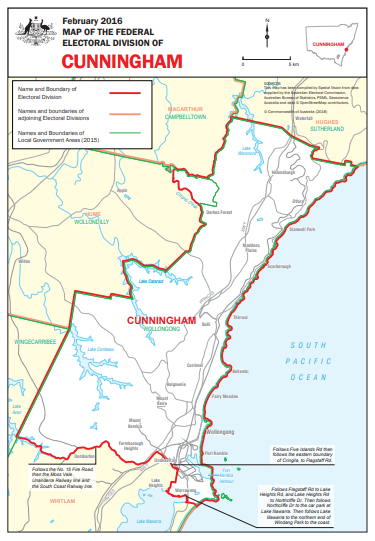|
|
|
|
| Adam Carr's Election Archive
|
Australian federal election, 2022
Division of Cunningham, New South Wales
Named for: Allan Cunningham (1791-1839), explorer of NSW and
Queensland
South of Sydney: Bulli, Corrimal, Port Kembla, Unanderra, Wollongong
State seats: All of
Keira, parts of
Heathcote,
Shellharbour and
Wollongong
Local government areas: Parts of
Wollondilly and
Wollongong
Borders with:
Hughes,
Hume,
Macarthur and
Whitlam
Enrolment at 2019 election: 115,312
Enrolment at 2022 election: 117,309 (+01.7)
1999 republic referendum: Yes 53.6
2018 same-sex marriage survey: Yes 65.7
Sitting member: Hon Sharon Bird (Labor):
Elected 2004, 2007, 2010, 2013, 2016, 2019. Retiring 2022
2007 Labor majority over Liberal: 18.1%
2010 Labor majority over Liberal: 13.2%
2013 Labor majority over Liberal: 9.9%
2016 Labor majority over Liberal: 13.3%
2019 Labor majority over Liberal: 13.4%
Liberal two-party vote 1983-2019
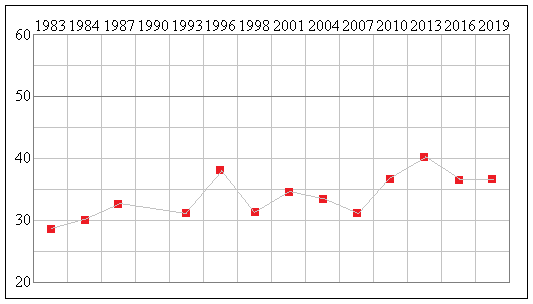
Status: Safe Labor
Best Labor booths, two-party vote: Warrawang (77.8) Warrawang Central (76.9),
Port Kembla Central (76.5), Lake Heights (76.3), Bellambi (75.8)
Best Liberal booths, two-party vote: Helensburgh (48.9), Unanderra West (44.4), Figtree Heights (42.3),
Wollongong PPVC (42.0), Cordeaux Heights (41.4)
2019 results
Statistics and history
Candidates in ballot-paper order:
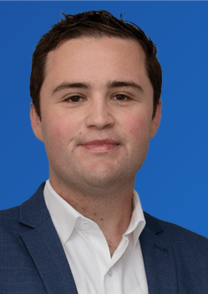 |
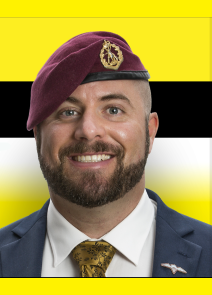 |
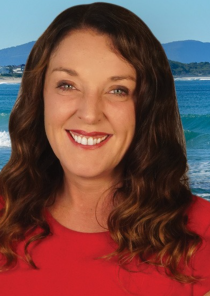 |
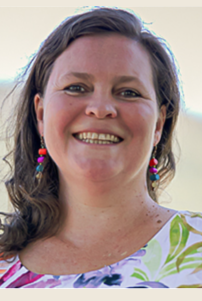 |
1. Marcus Uren
Liberal Party |
2. Ben Britton
United Australia Party |
3. Alison Byrnes
Australian Labor Party |
4. Alexis Garnaut-Miller
Citizens Party |
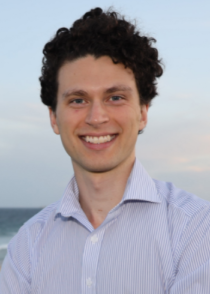 |
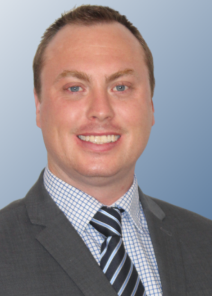 |
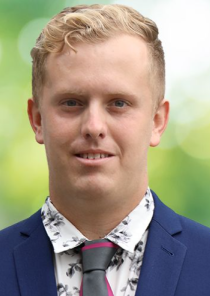 |
5. Dylan Green
Australian Greens |
6. Michael Glover
Liberal Democrats |
7. Thomas Grogan
Pauline Hanson's One Nation |
Candidate websites:
Benjamin Britton
Alison Byrnes
Alexis Garnaut-Miller
Michael Glover
Dylan Green
Thomas Grogan
Marcus Uren
Division of Cunningham
Cunningham was created in 1949, based on the industrial centre of Wollongong, south of Sydney. As
the region's heavy industry has declined, however, Wollongong has become a signicantly less
working-class city, and the creation in 1984 of the new seat of
Throsby (now
Whitlam) removed some of
the most blue-collar parts of the electorate. Today more of Cunningham's workforce work in government
services for the Illawarra region than work in manufacturing. This is why the electorate has a higher
proportion of people with professional and managerial occupations and a higher median income level than most
regional city seats.
All this explains the gradual decline in Labor strength in Cunningham, although the seat is still fairly
reliably Labor. Its members have included Labor cabinet ministers
Rex Connor and
Stewart West and Speaker
of the House
Stephen Martin. In 2002 Martin abruptly resigned his seat, and the ensuing by-election
found Labor with a new leader,
Simon Crean, whose standing with the public was low, and a candidate,
Sharon Bird, who many Labor activists in the seat did not support. The result was a shock win for the
Green candidate
Michael Organ, a blow from which Crean's leadership never recovered. At the 2004 election
things returned to normal and Bird easily regained the seat for Labor.
Sharon Bird, Labor MP for Cunningham since 2004, was a senior project officer with the NSW Department of
Juvenile Justice before her election. Earlier she had been a member of Shellharbour City Council.
She became a parliamentary secretary in 2012 and was a minister in the last months of the Rudd-Gillard
Government. She was a shadow minister until 2016. In November 2021 she announced her retirement. The new Labor candidate is
Alison Byrnes, who is currently Bird's electorate officer. The Liberal candidate is Marcus Uren, an account manager.
The Greens candidate is Dylan Green, whose occupation is not
stated.
Demographics:
Median weekly household income: $1,372 (Australia $1,438)
People over 65: 17.4% (Australia 15.8%)
Indigenous: 2.2% (Australia 2.8%)
Australian born: 71.8% (Australia 66.7%)
Non-English-speaking households: 21.1% (Australia 22.2%)
Catholics 25.2% (Australia 22.6%)
No religion 29.0% (Australia 29.6%)
University graduates: 23.0% (Australia 22.0%)
Professional and managerial employment: 37.0% (Australia 35.2%)
Employed in manufacturing and construction: 23.3% (Australia 22.9%)
Paying a mortgage: 29.7% (Australia 34.5%)
Renting: 32.2% (Australia 30.9%)
Traditional families: 31.5% (Australia 32.8%)
<Back to main page
| |

